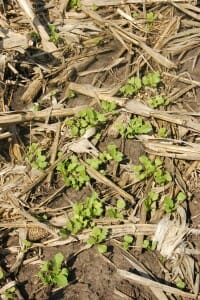Brassica cover crops as biofumigants
Last month, I attended a workshop on cover crops for fruit and vegetable farms, hosted by Iowa State University Extension.
An especially interesting part of the workshop for me was the talk on the cover crops as biofumigants in vegetable production. Brassica cover crops including radish, mustard and turnip can suppress pests such as insects, nematodes, weeds and fungi. Because of the ability of brassica cover crops to produce toxic compounds that are effective for suppressing pests, they are called biofumigants. Biofurmigation refers to the process of breaking down brassica cover crops, releasing toxic compounds and incorporating them into the soil.
However, simply planting brassica cover crops does not automatically improve everything, of course. For example, while brassica cover crops improved yields for celery, onion and eggplants in some studies, Dr. Ajay Nair at Iowa State University talked about the study in which musk melon suffered lower yield after brassica cover crops. The cause, he explained, was most likely because the period between biofumigation and melon seeding was too short. Also, when using brassica cover crops as biofumigants, Ajay reminded the workshop attendees to remember to mow all the time as mowing gives biofumigation capacity.
Besides the effect of biofumigation, Ajay also talked about how brassica cover crops in cucumber production had a positive impact in terms of attracting pollinators by bringing a lot of bees. However, at the same time they also attracted cucumber beetles which caused a lot of cull fruits.
Here are the links to some articles on biofumigation:
http://www.growingproduce.com/article/22140/the-organic-report-the-potential-of-brassica
http://www.michiganorganic.msu.edu/uploads/files/31/Mustard%20Bulletin.pdf
Could the effect of brassica cover crops as biofumigants potentially be a cooperators’ project next year? Any thoughts on this topic?

